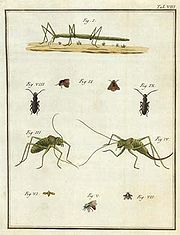
Pietro Rossi
Encyclopedia

Italian people
The Italian people are an ethnic group that share a common Italian culture, ancestry and speak the Italian language as a mother tongue. Within Italy, Italians are defined by citizenship, regardless of ancestry or country of residence , and are distinguished from people...
scientist
Scientist
A scientist in a broad sense is one engaging in a systematic activity to acquire knowledge. In a more restricted sense, a scientist is an individual who uses the scientific method. The person may be an expert in one or more areas of science. This article focuses on the more restricted use of the word...
and entomologist.
Rossi's academic career was conducted at the University of Pisa, where he attained a doctorate in philosophy
Philosophy
Philosophy is the study of general and fundamental problems, such as those connected with existence, knowledge, values, reason, mind, and language. Philosophy is distinguished from other ways of addressing such problems by its critical, generally systematic approach and its reliance on rational...
and medicine
Medicine
Medicine is the science and art of healing. It encompasses a variety of health care practices evolved to maintain and restore health by the prevention and treatment of illness....
in 1759. He was then made a professor of logic
Logic
In philosophy, Logic is the formal systematic study of the principles of valid inference and correct reasoning. Logic is used in most intellectual activities, but is studied primarily in the disciplines of philosophy, mathematics, semantics, and computer science...
in 1763, a position he held until 1801, when he finally received the chair for natural history
Natural history
Natural history is the scientific research of plants or animals, leaning more towards observational rather than experimental methods of study, and encompasses more research published in magazines than in academic journals. Grouped among the natural sciences, natural history is the systematic study...
with the special field "insectology", making him the world's first professor of entomology. His publications, particularly Fauna etrusca (1790) and Mantissa insectorum (1792), are considered pioneer achievements of entomology and still possess scientific validity in the fields of taxonomy
Taxonomy
Taxonomy is the science of identifying and naming species, and arranging them into a classification. The field of taxonomy, sometimes referred to as "biological taxonomy", revolves around the description and use of taxonomic units, known as taxa...
and biological nomenclature. Parts of his collection were once in the possession of Johann Christian Ludwig Hellwig
Johann Christian Ludwig Hellwig
Johann Christian Ludwig Hellwig was a German entomologist.After studies of mathematics and natural history at the university of Frankfurt, he became, in 1766, adviser to prince Wilhelm Adolf von Braunschweig at the time of his voyage in the south of Russia.In 1771, he taught in two colleges of...
in Braunschweig
Braunschweig
Braunschweig , is a city of 247,400 people, located in the federal-state of Lower Saxony, Germany. It is located north of the Harz mountains at the farthest navigable point of the Oker river, which connects to the North Sea via the rivers Aller and Weser....
; these are now in the Humboldt Museum
Humboldt Museum
The Museum für Naturkunde, officially the ' or Naturkundemuseum , occasionally known as the Humboldt Museum, is a natural history museum in Berlin, Germany. Usually the museum's name is abbreviated MFN...
for Natural History in Berlin. In 1793, he was elected a foreign member of the Royal Swedish Academy of Sciences
Royal Swedish Academy of Sciences
The Royal Swedish Academy of Sciences or Kungliga Vetenskapsakademien is one of the Royal Academies of Sweden. The Academy is an independent, non-governmental scientific organization which acts to promote the sciences, primarily the natural sciences and mathematics.The Academy was founded on 2...
. After his death, the Museo entomologico Pietro Rossi was integrated into the Museo Civico di Storia Naturale de Milan in Milan
Milan
Milan is the second-largest city in Italy and the capital city of the region of Lombardy and of the province of Milan. The city proper has a population of about 1.3 million, while its urban area, roughly coinciding with its administrative province and the bordering Province of Monza and Brianza ,...
.
External links
- BHL Scan of Fauna Etrusca
- BHL Scan of Mantissa insectorum
- Augusto Vigna Taglianti, L'entomologia nella scienza italiana, con particolare riguardo alla Accademia Nazionale delle Scienze detta dei XL (Vortrag vom 13. Nov. 2003)

